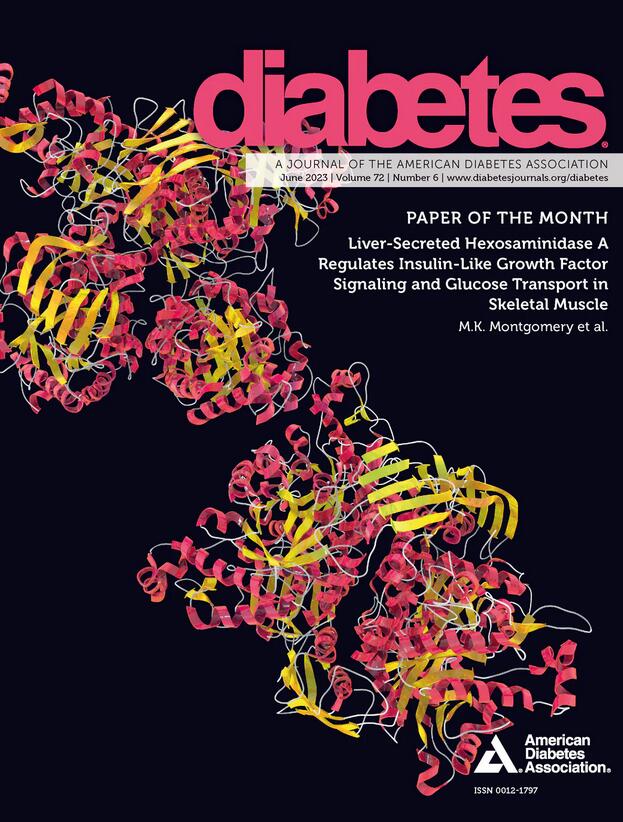392-P: Metabotypes to Define Cardiorenal Risk in People with Type 1 Diabetes
IF 7.5
1区 医学
Q1 ENDOCRINOLOGY & METABOLISM
引用次数: 0
Abstract
Introduction and Objective: Cardio-renal complications are the leading source of morbidity in people with type 1 diabetes (T1D). While previous metabolomic studies have characterized incident and predictive metabolic signatures (metabotypes) of diabetic kidney disease (DKD) and cardiovascular autonomic neuropathy (CAN) in separate T1D cohorts, no previous study has investigated CAN and DKD in the same subset of T1D patients. In this study we sought to identify shared and unique metabotypes of T1DKD and CAN in 120 T1D subjects. Methods: Baseline blood samples were processed for central carbon and lipidomic LC/MS analysis. DKD and CAN were defined as eGFR < 60 mL/min/1.73m2 and/or elevated albumin/creatinine (ACR), and prior validated cut-offs for indices of heart rate variability (SDNN, RMSSD). We used logistic regression to assess ability of metabolic feature/classes associating with incident and progression of DKD and CAN before and after adjusting for age, gender, race, diabetes duration and BMI. Results: Among 120 T1D subjects (mean age 48 years, mean A1c 8.2%; 42 % women) a unique panel of metabolites associated with incident DKD (with amino acids showing AUC of > 0.7 for eGFR and ACR) and CAN (peptides AUC > 0.7). In a subset of subjects with available follow-up data in adjusted analysis baseline azolines and glycerophosphoinositols were associated DKD progression (new decline in eGFR at follow-up < 60 or elevation of ACR compared with baseline). Unadjusted data showed baseline azolines, peptides and steroids may associate with progression of CAN while in adjusted analysis this was no longer significant presumably due to small numbers of subjects that exhibited progression. Conclusion: These data suggest that distinct metabotypes associate with T1D DKD and CAN at baseline, a subset of which associate with DKD progression. Ongoing studies will focus on identifying predictive CAN progression markers as more follow-up data becomes available for risk stratification in people with T1D. Disclosure L. Ang: None. Y. Huang: None. F. Afshinnia: None. M. Banerjee: None. C. Martin: None. P. Ramkumar: None. M. Kretzler: Research Support; AstraZeneca, Boehringer-Ingelheim, Chinook Therapeutics, Inc, Eli Lilly and Company, Moderna, Inc, Janssen Pharmaceuticals, Inc, National Institutes of Health, European Union. Advisory Panel; Novartis Pharmaceuticals Corporation. Research Support; Novo Nordisk. Advisory Panel; Otsuka America Pharmaceutical, Inc. Research Support; Regeneron Pharmaceuticals, Renalytix, Roche Pharmaceuticals, Sanofi, Travere, Certa, Dimerix. S. Pennathur: Research Support; Aurinia. R. Pop-Busui: Board Member; American Diabetes Association. Consultant; Averitas Pharma, Inc. Research Support; Bayer Pharmaceuticals, Inc. Other Relationship; Biogen. Research Support; Juvenile Diabetes Research Foundation (JDRF). Advisory Panel; Lexicon Pharmaceuticals, Inc, Novo Nordisk. Research Support; Novo Nordisk, National Institute of Diabetes and Digestive and Kidney Diseases. Consultant; Roche Diagnostics. Funding Supported by Breakthrough T1D (former JDRF) Center of Excellence grant 2019-861RPB was also supported by 1-R01-DK126837-01A1392-P:代谢型定义1型糖尿病患者的心肾风险
前言和目的:心肾并发症是1型糖尿病(T1D)患者发病的主要原因。虽然之前的代谢组学研究已经在单独的T1D队列中描述了糖尿病肾病(DKD)和心血管自主神经病变(CAN)的事件和预测代谢特征(代谢型),但之前没有研究在相同的T1D患者亚群中研究了CAN和DKD。在这项研究中,我们试图在120名T1D受试者中确定T1DKD和CAN的共享和独特代谢型。方法:对基线血样进行中心碳和脂质组学LC/MS分析。DKD和CAN定义为eGFR &;lt;60 mL/min/1.73m2和/或白蛋白/肌酐(ACR)升高,以及先前验证的心率变异性指标的截止值(SDNN, RMSSD)。我们使用逻辑回归来评估在调整年龄、性别、种族、糖尿病病程和BMI之前和之后与DKD和CAN的发生和进展相关的代谢特征/类别的能力。结果:120例T1D患者(平均年龄48岁,平均A1c 8.2%;42%的女性)与DKD事件相关的一组独特代谢物(氨基酸显示AUC为&;gt;eGFR和ACR为0.7)和CAN(肽AUC &;gt;0.7)。在调整分析中有可用随访数据的受试者子集中,基线唑啉和甘油磷酸肌醇与DKD进展相关(随访时eGFR再次下降);60或与基线相比ACR升高)。未经调整的数据显示,基线的氮唑类药物、多肽和类固醇可能与CAN的进展有关,而在调整后的分析中,这可能是由于少数受试者表现出进展而不再显著。结论:这些数据表明,在基线时,不同的代谢型与T1D DKD和CAN相关,其中一部分与DKD进展相关。随着更多的随访数据可用于T1D患者的风险分层,正在进行的研究将集中于识别预测的CAN进展标志物。L. Ang:没有。黄:没有。F.阿富汗:没有。班纳吉:没有。马丁:没有。P. Ramkumar:没有。M. Kretzler:研究支持;阿斯利康、勃林格殷格翰、奇努克治疗公司、礼来公司、Moderna公司、杨森制药公司、美国国立卫生研究院、欧盟。顾问小组;诺华制药公司。研究支持;诺和诺德公司。顾问小组;大冢美国制药株式会社研究支持;Regeneron Pharmaceuticals, Renalytix, Roche Pharmaceuticals, Sanofi, Travere, Certa, Dimerix。S. Pennathur:研究支持;Aurinia。R. Pop-Busui:董事会成员;美国糖尿病协会。顾问;Averitas Pharma, Inc.研究支持;拜耳制药公司其他关系;生原体。研究支持;青少年糖尿病研究基金会(JDRF)。顾问小组;Lexicon制药公司,诺和诺德。研究支持;诺和诺德,国家糖尿病、消化和肾脏疾病研究所。顾问;罗氏诊断。突破T1D(原JDRF)卓越中心基金2019-861RPB资助,1-R01-DK126837-01A1资助
本文章由计算机程序翻译,如有差异,请以英文原文为准。
求助全文
约1分钟内获得全文
求助全文
来源期刊

Diabetes
医学-内分泌学与代谢
CiteScore
12.50
自引率
2.60%
发文量
1968
审稿时长
1 months
期刊介绍:
Diabetes is a scientific journal that publishes original research exploring the physiological and pathophysiological aspects of diabetes mellitus. We encourage submissions of manuscripts pertaining to laboratory, animal, or human research, covering a wide range of topics. Our primary focus is on investigative reports investigating various aspects such as the development and progression of diabetes, along with its associated complications. We also welcome studies delving into normal and pathological pancreatic islet function and intermediary metabolism, as well as exploring the mechanisms of drug and hormone action from a pharmacological perspective. Additionally, we encourage submissions that delve into the biochemical and molecular aspects of both normal and abnormal biological processes.
However, it is important to note that we do not publish studies relating to diabetes education or the application of accepted therapeutic and diagnostic approaches to patients with diabetes mellitus. Our aim is to provide a platform for research that contributes to advancing our understanding of the underlying mechanisms and processes of diabetes.
 求助内容:
求助内容: 应助结果提醒方式:
应助结果提醒方式:


